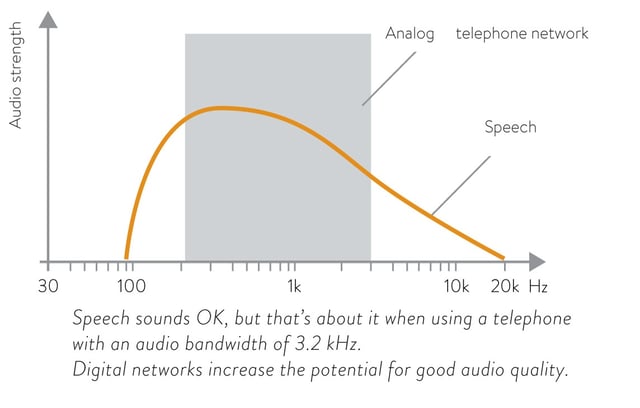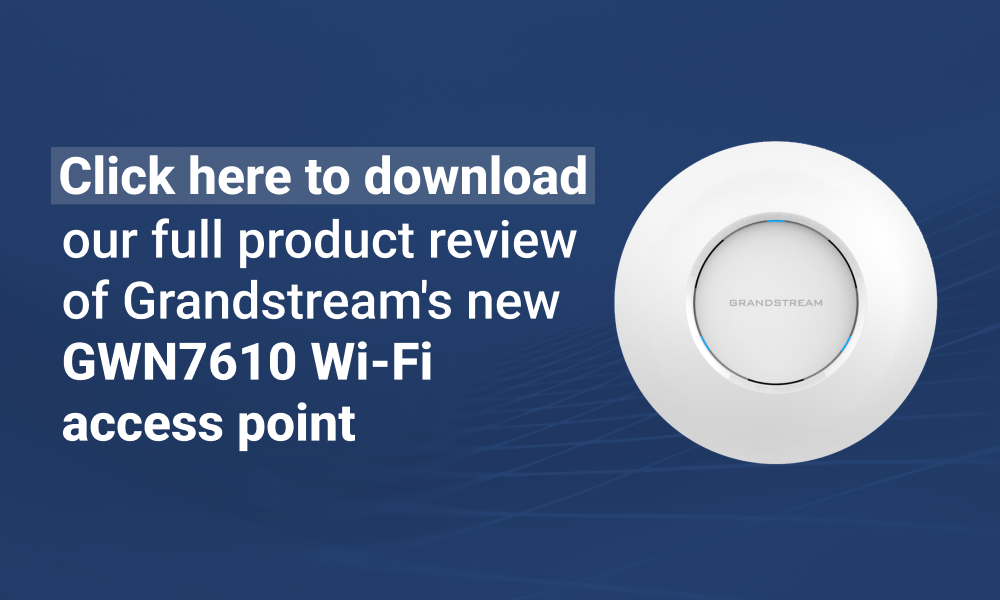.jpg?width=1024&name=network(Konftel).jpg)
By Stefan Eriksson, Marketing and Communications Manager of Konftel
Remote meetings with poor quality audio are often exhausting. Misunderstandings become more likely because it’s difficult to hear nuances and other subtleties in conversation. So you want to aim for the best sound quality possible during teleconferences. The following is a quick explanation of different technical requirements for audio quality.
- A purely mobile solution gives you great flexibility and mobility, but sometimes at the expense of sound quality. Many mobile operators now offer HD Voice in their networks, which delivers HD audio if the phone supports the technology.
- Traditional analog telephony delivers an acceptable sound quality, but with limitations in frequency range. Sometimes known as telephone quality or narrowband.
- VoIP, i.e., digital telephony via the data network (voice over IP), allows for extended frequency range, but with some compression. IP makes it possible to achieve superior audio quality, also called HD audio or wideband.
- Remember that all local networks and accessories, e.g. Wi-Fi, DECT (wireless telephony) or Bluetooth®, affect the transmission capacity and can have an adverse impact on the sound quality.
- All of Konftel’s phones and conference units offer HD audio in contexts where PBXs and networks support it.
SOUND AND AUDIBILITY
A person is able to perceive sounds between 20 and 20,000 Hz (20 Hz – 20 kHz). This changes as we grow older and because of physical factors. An adult normally distinguishes sounds at frequencies between about 20 Hz and 12 kHz. The concept of “telephone quality” was used in the past; an interval in which the frequency range, due to technical shortcomings, was limited to between 200 Hz and 3.4 kHz (i.e. a total of 3.2 kHz). Today, it’s termed narrowband (compare this with wideband further on).
With an analog telephone system, this means losing a large part of the speech’s frequency range. This makes the speech less natural and more difficult to understand than if the frequency range had been greater. Compare this with FM radio, which has a frequency range of up to 15 kHz, enabling both voices and music to be reproduced much more naturally.
ANALOG TELEPHONY
Analog telephony has an extremely limited frequency response (approx. 3.2 kHz). However, in an analog network, the audio signal is not processed to the same extent as in a digital network. The analog signal is perceived by some as more natural, even though the digital signal in general has a wider frequency range. This is because the human ear is very good at perceiving artificial sound.
DATA BANDWIDTH AND FREQUENCY RANGE
The term ’bandwidth’ insofar as data is concerned refers to the amount of information that can be transferred per second in a network. The frequency range, however, refers to the sound frequencies that can be transmitted. The unit is Hertz (Hz) for both the concepts, which can unfortunately sometimes lead to misunderstandings as frequency range and data bandwidth are not the same thing. Moreover, the fact that bandwidth can be expressed as both Hertz and bits per second (the capacity in the network; you usually see Mbps) doesn’t make it any less confusing. Sound is converted in digital networks. The sound signal is measured, or sampled, thousands of times per second and converted to digital data.
Lowering this sampling frequency reduces the amount of data to be transmitted, but it also causes some of the subtleties in the sound to be lost. These small details can be masked by stronger signals and thus reduce the clarity.
MOBILE TELEPHONY
Depending on what data capacity the mobile networks of the different operators have, the audio signal is always more or less band-limited to save on the transmission capacity. Sound in 2G networks only permits narrowband (3.2 kHz) while 3G and 4G networks permit wideband (7 kHz). More recently, a number of operators have started using wideband standards and have launched so-called HD Voice services. However, for this technology to work, the telephone also has to be able to handle this standard, which most modern telephones do. Poor transmitting and receiving conditions can also have an impact on sound quality. The system automatically reduces the transmission speed in the network when conditions are poor. This has a detrimental effect on the sound quality despite the fact that sound is always given priority in transmissions (over images, for instance).
VOIP, WIDEBAND AND CODEC
Telephony over the data network is called VoIP (voice over IP). The sound in the digital networks was initially produced to deliver roughly the same sound quality that has been accepted and become a standard in the old analog technology, i.e. 3.2 kHz audio bandwidth (telephone quality or narrowband). This was a necessity in the early digital networks, as data bandwidth was clearly limited back then.
In digital networks, the sound quality is limited primarily by the codec that has been chosen.

A codec is a piece of software in the telephone that compresses outgoing analog sound into data packages and converts incoming data packages into analog sound. The telephones transmit the sound using the best possible common codec. Modern phones, which support wideband codecs, are therefore better able to achieve the best possible sound. The last 10 to 15 years have seen fantastic advances in the capacity of VoIP.
Common designations for various codecs are: wideband codec (7 kHz), super wideband codec (14 kHz) and full bandwidth codec (20 kHz). There are also a wide range of technical solutions and standards with names such as G.718, G.722.2, G.729.1 and so on. In everyday speech, we say HD audio or wideband for sound qualities that use 7 kHz or more.
WIRELESS SOLUTIONS
The distribution capacity of the broadband network and/or mobile network to the office is, of course, what determines how good the sound can be. It is also important to consider the office’s internal structure, because anything added outside the telephony network can interrupt the chain and reduce the capacity of the audio bandwidth. This could be wireless systems, such as DECT and Bluetooth®, or old network products.
Bluetooth®
Bluetooth® is a standard that was originally developed to enable various accessories to connect wirelessly to a mobile phone or computer. Bluetooth® only works over short distances between a mobile phone and its accessories. There is additional data compression of the sound signal, which can adversely affect sound quality. The trend is increasingly towards modern Bluetooth® technology supporting HD audio.
DECT and CAT-iq
DECT solutions for wireless telephony in offices and industrial premises were originally developed for use with analog telephony. No matter how much capacity is available to an old DECT transmitter, it is simply not possible to produce more than the standard sound quality of a telephone (3.2 kHz) in such a DECT network. You lose more than 3 kHz for all calls transmitted via an old DECT system if you’re using wideband codec (7 kHz) in a VoIP network. This hardly matters for normal telephone calls, but if you are using such a combination and want to hold meetings where sound quality is particularly important, it may be a good idea to use direct connections (cables) to the VoIP network.
Put simply, CAT-iq is a digital enhancement of DECT. A CAT-iq system has wideband codecs and thus allows a 7 kHz audio bandwidth, which is excellent capacity for wireless connections to a VoIP system. IP DECT solutions for HD audio are available today.
KONFTEL’S SOLUTIONS
Konftel’s products always deliver optimum sound quality in relation to network capacity. If the network distributes HD audio, you’ll get HD audio on Konftel’s conference phones.
CONCLUSION
This brief explanation of audio distribution shows there is reason to analyze the communication needs of your business and organization before choosing a network and updating your telephony and data infrastructure. For example, a VoIP network with wideband codecs (7kHz) is better equipped to deliver superior audio than an analog or old mobile network. That may be obvious, but on the other hand, mobility and simplicity can be key considerations in certain contexts.
To learn more about sound and ensuring the best possible audio quality for your remote meetings, join Dr. Sound at our online Audio Academy.
Konftel is a leading audio conferencing solutions manufacturer. Subscribe to Konftel's YouTube channel and learn more about holding effective meetings at their Learn & Inspire center. You can also follow them on LinkedIn and Facebook.
Browse TeleDynamics' website for Konftel products.
You may also like:
Cordless SIP phones in the workplace: DECT vs. VoWi-Fi
Time-saving telephone network installation tips
Grow your business and boost customer satisfaction with VoIP phone system integrations






Add a Comment: